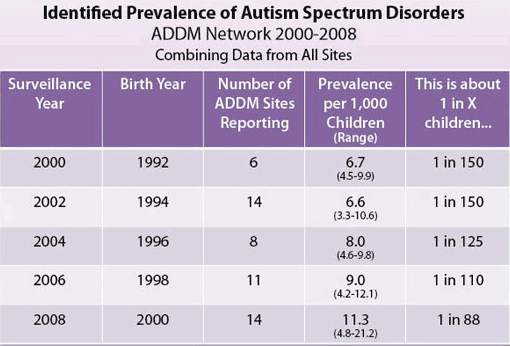By Deshe Taylor & Casey Williams; reviewed by M. Williams, Ph.D.
Autistic Disorder, or Autism, is a developmental disorder that interferes with the ability to communicate with and relate to others.
Autistic disorder was included in the the psychiatrist's manual, the DSM-III, in 1980 and remains in the DSM-IV-TR today under the heading of Pervasive Developmental Disorders (PDD). A PDD is defined as a category of unusual psychological problems that begin early in life and involve severe impairments in several areas of functioning. One type of PDD includes Asperger's syndrome, a miler form of autistic disorder.
Autism is usually evident within the first three years of life and is more prevalent in boys than girls. It seems that the prevalence of autistic disorder is increasing, as illustrated by the following chart.

Chart from Centers for Disease Control and Prevention
Symptoms of Autistic Disorder
Common symptoms of autism include a lack of social interaction and communication with others, demonstration of repetitive behaviors, preoccupation with lights, moving objects, or parts of objects, strong dislike to noise, and ritualistic behaviors. Because of the repetitive behaviors involved in the disorder, it has been suggested that autism is part of the obsessive-compulsive spectrum of disorders.
Autistic patients are disinterested in physical contact with other people, are unaffectionate as babies, and avoid making eye contact. They have delayed language that is rarely used to talk to others or they do not develop language at all. They will often repeat words or phrases over and over like an echo. They have repetitive motor movements such as waving their hands up in down in a fan like motion or rocking back and forth. They usually must do everything (eating, getting dressed, etc.) in a routine manner. At times they may even self-mutilate (i.e. banging their head against a wall).
Some autistics have a rare savant syndrome, an outstanding ability in areas like art, music, and memory skills. It is not quite understood where these abilities come from, and there is currently research being done in this area.
Autistic people have the capability to focus their attention on one thing for an indefinite period of time. For this reason, they may be able to extrapolate information about a particular object that other people that cannot do because other people are unable to focus the same amount of attention for a prolonged period. This could result in the savant phenomenon or the perception that the autistic person is actually gifted, despite being afflicted with this disorder.
Causes of Autistic Disorder
The theoretical causes of autism include psychological and social, environmental, and biological factors. It used to be thought that autism was a result of bad parenting by "refrigerator parents" but that theory has been disproven. Another theory is that the toxins and teratogens in the environment could be causing the disorder but to date there is no firm evidence of this.
There are several theories that include biological factors. Some abnormality in brain structures could be the cause. Research has been done on the left hemisphere because it controls speech, the limbic system since it is responsible for emotion, the cerebellum which is responsible for sensory motor output, and the frontal lobe which controls executive functioning. This research has been complicated because many areas in the brain can be damaged during autism and it isn't a result of brain damage but a disorder in brain development.
Research suggests that autism is can also be a genetic condition, which has been shown from many twin studies; and the fact that it is gender-linked, with a higher prevalence rate in boys, also points to genetic factors. Another possibility is that it is a result of already known biological disorders because it has a high comorbidity with mental retardation, PKU, rubella, encephalitis, tuberous sclerosis, and fragile-X syndrome. None of these theories have been proven, and there is much research being done, but it is evident that autism has multiple pathways and has many different causes.
Treatment for Autism
Treatments for autism include behavior therapy and medication. Behavior therapy can teach social, motor, and cognitive thinking skills. Behavior therapy must be formed to the individual because the disorder can vary in severity in each child. It is intensive behavior therapy during childhood that involves the parents and is also home-based has been shown to produce the best results.
Medication can also be used along with behavior therapy but it is not used as a cure rather an alleviation of certain symptoms. SSRI's, antidepressants, amphetamines, psychedelics, and megavitamins have been known to be used. Neither medication nor therapy can effect a complete cure. More research needs to be done to better understand and treat this baffling disorder.



